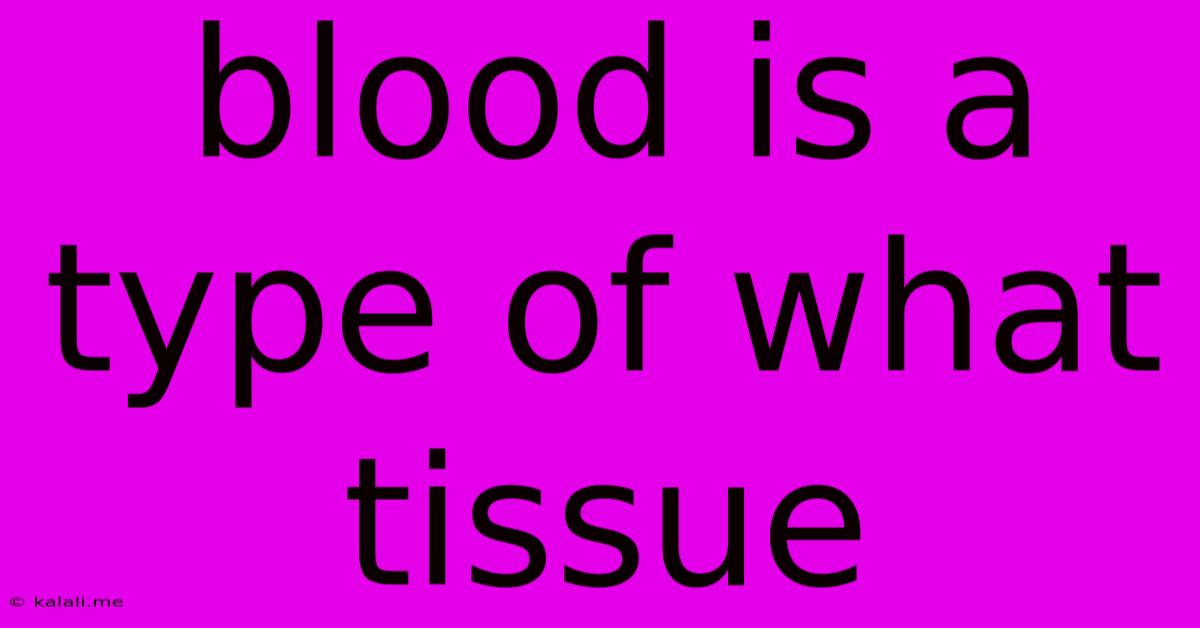Blood Is A Type Of What Tissue
Kalali
Jun 14, 2025 · 3 min read

Table of Contents
Blood: A Connective Tissue with a Vital Role
Blood is often overlooked, but it's a fundamental component of our bodies, crucial for survival. Understanding its classification as a connective tissue is key to appreciating its multifaceted functions. This article delves into the characteristics of blood, explaining why it's categorized as a connective tissue and exploring its essential roles in maintaining our health.
Blood, the fluid that circulates through our circulatory system, is far more complex than just a red liquid. It's a specialized connective tissue that transports vital substances throughout the body. Unlike other connective tissues like bone or cartilage, blood doesn't provide structural support. Instead, its function is to connect different parts of the body by transporting various components. This includes oxygen, nutrients, hormones, waste products, and immune cells.
Why Blood is Classified as a Connective Tissue
The classification of blood as a connective tissue might seem surprising at first glance. However, examining its composition reveals its connective tissue nature:
-
Extracellular Matrix: Blood possesses an extracellular matrix, although it's liquid, unlike the solid matrices of other connective tissues. This liquid matrix, known as plasma, constitutes the bulk of blood volume. It's a complex mixture of water, proteins, ions, and various dissolved substances.
-
Cells: Blood contains numerous specialized cells suspended within the plasma. These cells are the main working units of blood and include:
- Red blood cells (erythrocytes): These are responsible for carrying oxygen from the lungs to the body's tissues.
- White blood cells (leukocytes): These are essential components of the immune system, defending the body against infection and disease. Several types of leukocytes exist, each with unique roles.
- Platelets (thrombocytes): These cell fragments are crucial for blood clotting, preventing excessive bleeding from injuries.
These cellular components, suspended in the plasma matrix, fulfill the connective function by linking different parts of the body. This connection is established through the transportation of essential molecules and cells.
The Crucial Functions of Blood
Blood's connective tissue nature underpins its diverse and critical functions:
-
Transportation: This is arguably the most significant function. Blood transports oxygen from the lungs to the tissues, and carbon dioxide from the tissues to the lungs for exhalation. It also carries nutrients absorbed from the digestive system to cells throughout the body, and hormones from endocrine glands to their target organs. Waste products, such as urea, are transported to the kidneys for excretion.
-
Regulation: Blood plays a vital role in maintaining homeostasis, the body's internal balance. It regulates body temperature, pH, and fluid balance.
-
Protection: Blood's immune cells protect the body against infection and disease. Furthermore, the clotting process prevents excessive blood loss following injury.
Conclusion
In summary, blood is a unique and essential connective tissue characterized by its liquid extracellular matrix (plasma) and diverse cellular components. Its ability to connect different parts of the body through transport, regulation, and protection makes it indispensable for life. Understanding its classification and functions highlights its importance in maintaining overall health and well-being. Further exploration into the intricacies of hematology reveals even greater depths of this fascinating and crucial bodily fluid.
Latest Posts
Latest Posts
-
How To Find Base Of A Cylinder
Jun 15, 2025
-
Find The Square Root Of 361
Jun 15, 2025
-
The Genetic Identity Of Human Males Is Known By The
Jun 15, 2025
-
What Is The Antonym Of Rural
Jun 15, 2025
-
What Is The Correct Order Of Piagets Stages Of Development
Jun 15, 2025
Related Post
Thank you for visiting our website which covers about Blood Is A Type Of What Tissue . We hope the information provided has been useful to you. Feel free to contact us if you have any questions or need further assistance. See you next time and don't miss to bookmark.